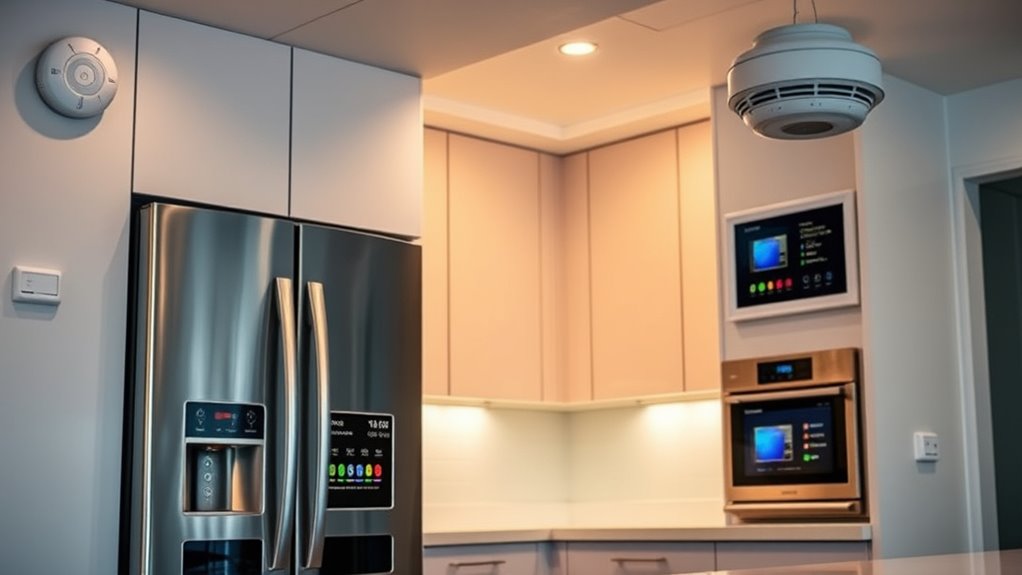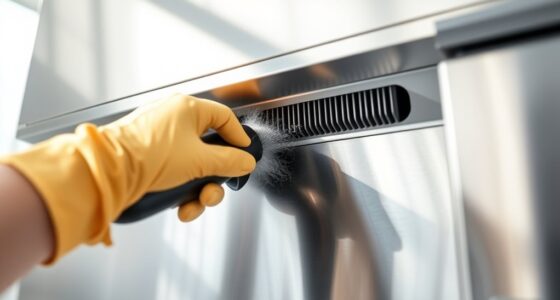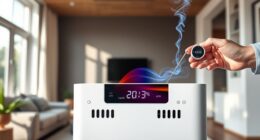Home automation systems use sensors to monitor your appliances for hazards like overheating, water leaks, or gas leaks. They send alerts via notifications, alarms, or voice alerts to keep you safe. Smart detectors and sensors can trigger automatic shut-offs or safety responses to prevent damage or accidents. Customizing alert settings helps match your needs. If you want to discover more about protecting your home with automation, keep exploring how these systems work.
Key Takeaways
- Appliance sensors monitor parameters like temperature, humidity, and electrical current to detect hazards and trigger safety alerts.
- Integration of smoke, gas, and water leak detectors enables instant alerts and automatic safety responses in home automation systems.
- Overheat notifications are sent via mobile, voice, and visual alerts to prevent appliance damage and safety risks.
- Customizable safety thresholds and AI-driven predictive analytics enhance early hazard detection and automated shut-off features.
- Regular maintenance, system updates, and testing ensure reliable safety alerts and optimal performance of home automation safety systems.
How Appliance Sensors Detect Potential Hazards
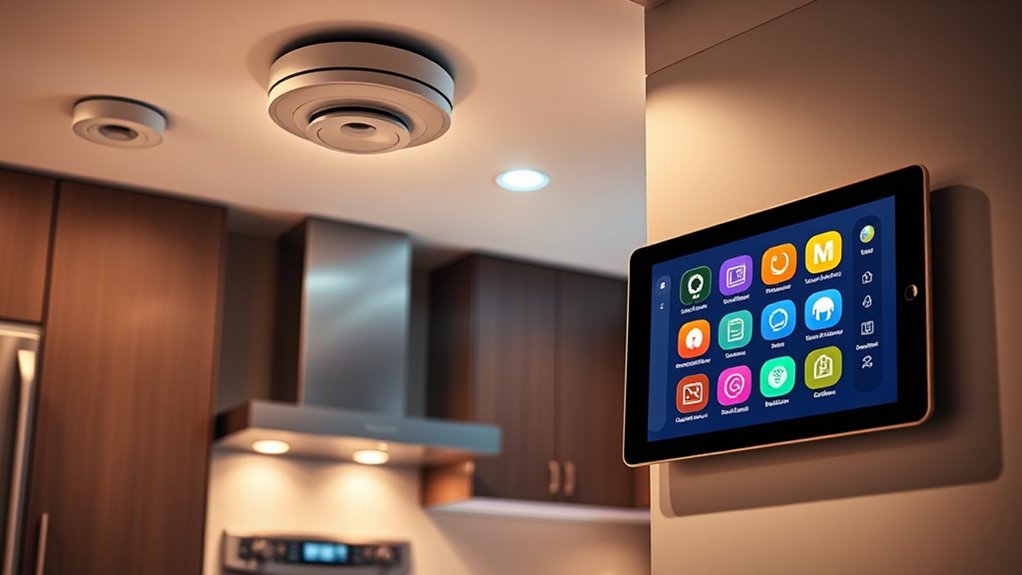
Appliance sensors actively monitor various parameters to identify potential hazards before they become dangerous. You’ll notice that these sensors constantly track temperature, humidity, motion, and electrical current. When a sensor detects abnormal readings—like an overheating motor or a sudden surge in electricity—it immediately triggers an alert. This quick detection helps prevent fires, electrical failures, or water damage. For example, a temperature sensor in your oven can sense if it’s overheating and shut it off or notify you. Similarly, humidity sensors can spot leaks or excess moisture that might cause mold or electrical shorts. By continuously monitoring these critical factors, appliance sensors serve as an early warning system, giving you time to intervene and avoid serious issues. Additionally, incorporating sensor technology into your home environment can promote relaxation and reduce stress, contributing to a safer and more comfortable living space. Implementing real-time monitoring enhances the effectiveness of these sensors by providing instant updates on potential risks, and understanding electrical safety guidelines can further help prevent accidents. Moreover, understanding cybersecurity vulnerabilities associated with connected devices can ensure your smart appliances remain protected from digital threats.
Types of Safety Alerts in Home Automation Systems
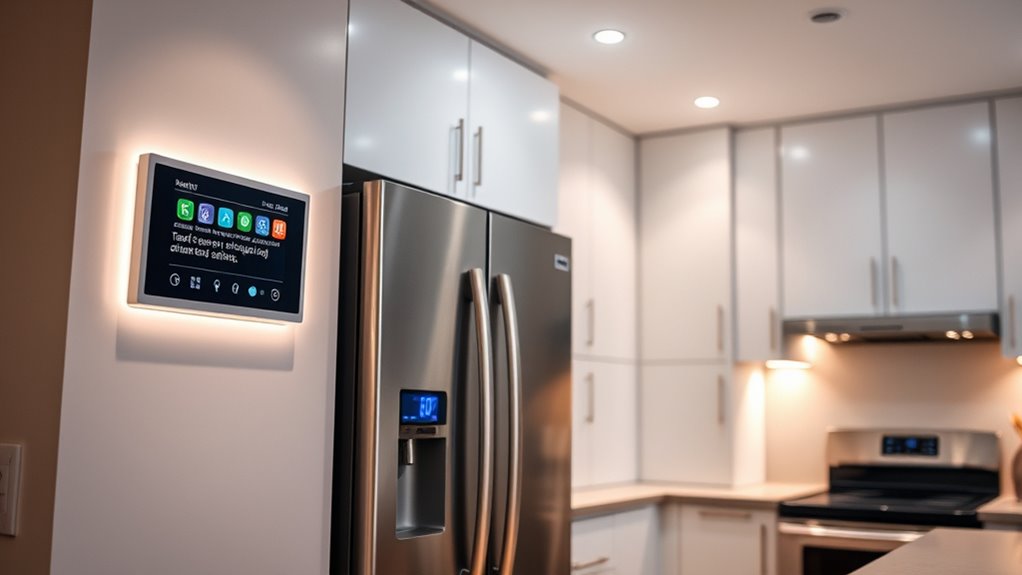
Home automation systems provide a variety of safety alerts to keep your household secure. You’ll receive notifications for issues like overheating appliances, electrical faults, or water leaks, so you can act quickly. These alerts often come as push notifications, emails, or voice alerts through smart speakers. Some systems also offer visual alerts on your smartphone app or control panel. For example, if a refrigerator’s compressor overheats, you’ll be alerted immediately. Similarly, alerts may warn you about power surges or abnormal appliance behavior. These safety notifications help prevent damage, reduce risks, and give you peace of mind. By customizing alert settings, you guarantee you’re promptly informed about potential hazards, keeping your home safe and appliances functioning smoothly. Incorporating professional equipment and continuous training enhances the effectiveness of your home automation safety system. Additionally, understanding beach environment factors such as wind and wave activity can inform the placement and durability features of outdoor smart devices.
Integrating Smoke and Gas Detectors With Appliances
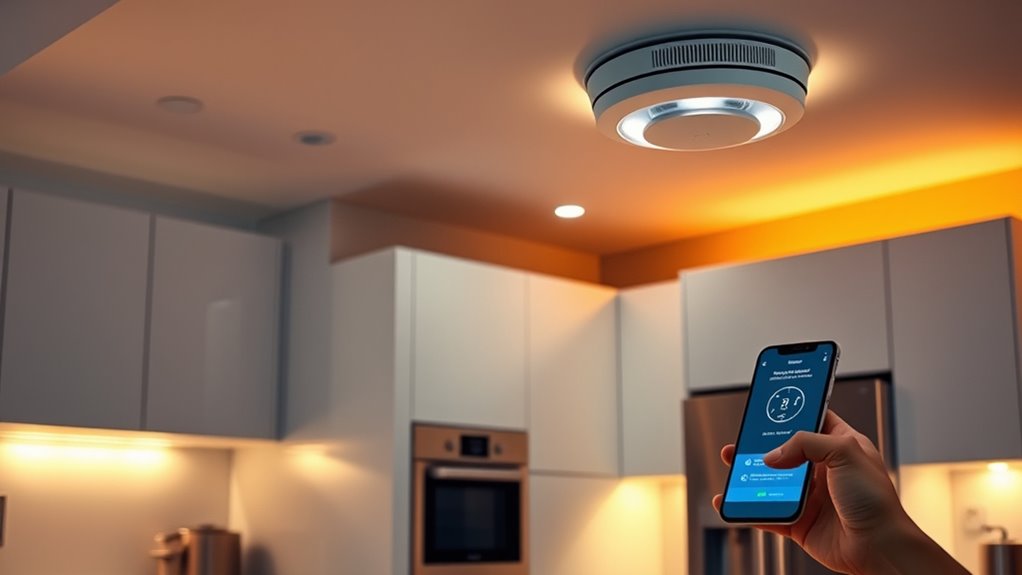
Have you considered how integrating smoke and gas detectors with your appliances can enhance your home’s safety? When these detectors are connected to your home automation system, you receive instant alerts on your phone or smart devices if smoke or gas is detected. This quick notification allows you to react promptly, whether that’s evacuating, ventilating, or shutting off appliances automatically. You can set up alerts for specific appliances, like your oven or furnace, so you’re always aware of potential hazards. Reliable safety monitoring plays a crucial role in early parenthood, ensuring a secure environment for your family. Additionally, integrating these detectors with your smart home system enables automatic safety responses, such as shutting off gas valves or activating exhaust fans, which can prevent accidents before they escalate. Incorporating advanced sensor technology can further enhance detection accuracy and reduce false alarms, providing even greater peace of mind. As home security systems increasingly incorporate smart technology, they offer more comprehensive safety solutions that adapt to your lifestyle and improve overall security. Understanding cookie usage and how it impacts your online experiences can also help you manage your privacy while setting up these smart systems.
Monitoring Water Leaks and Flood Risks

Installing leak detection sensors is a smart way to catch water leaks early and prevent damage. These sensors can send flood alert notifications straight to your phone, so you’re always in the know. By staying alert to potential flood risks, you can protect your home and belongings more effectively. Incorporating data-driven strategies into your home automation can further enhance your ability to respond quickly to emergencies. Regular maintenance of your plumbing system and understanding suction power can also help minimize the likelihood of leaks. Additionally, understanding GMC tuning principles can optimize your home’s water management systems for better efficiency, especially when integrated with smart home devices. Proper placement of sensors in high-risk areas such as basements and near appliances can improve detection accuracy and response times.
Leak Detection Sensors
Leak detection sensors are essential tools for monitoring water leaks and flood risks, providing real-time alerts to help prevent costly damage. When installed strategically, they detect even small leaks early on. To maximize their effectiveness, consider these key features:
- Sensitivity levels that allow customization based on your home’s needs.
- Wireless connectivity for seamless integration with your home automation system.
- Audible alarms and push notifications that guarantee immediate awareness of leaks.
- Proper placement and regular testing enhance their ability to detect water leaks early, ensuring your home remains protected.
Flood Alert Notifications
Flood alert notifications take leak detection a step further by providing real-time updates on water leaks and flood risks throughout your home. When sensors detect rising water levels or leaks in areas like basements, kitchens, or laundry rooms, the system instantly notifies you via your smartphone or connected device. This immediate alert helps you act quickly to prevent water damage, mold, or structural issues. Many home automation systems allow you to customize alerts based on specific zones or thresholds, ensuring you’re only notified when necessary. You can even automate responses, like shutting off the main water supply or activating pumps. Flood alerts give you peace of mind by keeping you informed of potential disasters before they escalate, saving you time, money, and stress.
Temperature and Overheat Notifications for Appliances
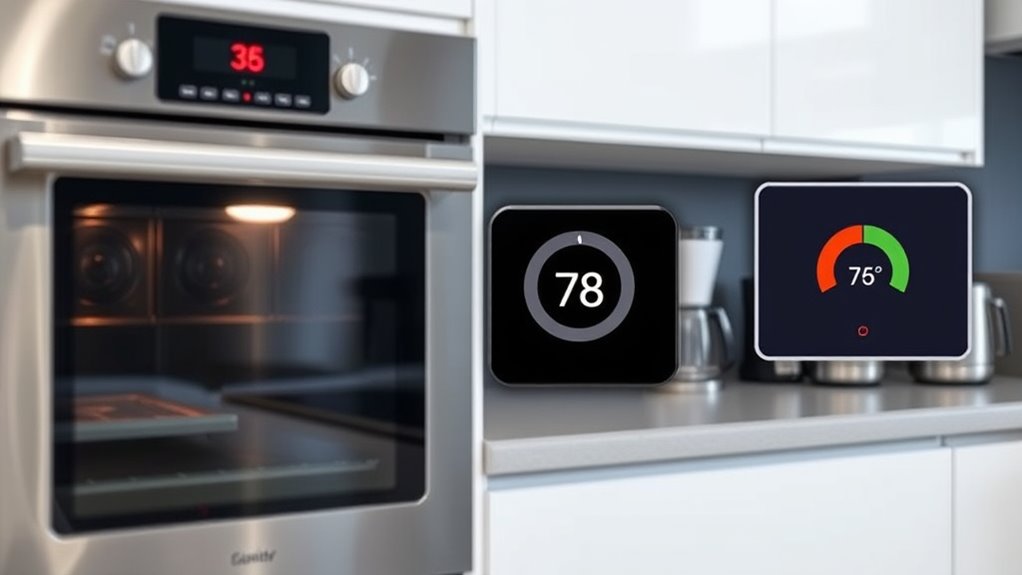
Many modern appliances now come equipped with temperature and overheat notifications to keep you safe. These alerts monitor internal components and trigger warnings when temperatures rise beyond safe limits. This proactive approach helps prevent damage and potential hazards. When an overheat occurs, you’ll receive notifications such as:
- Immediate alerts on your smart device to prompt quick action.
- Automated shutdown commands to prevent further overheating.
- Diagnostic information to identify the source of the heat issue.
Real-Time Alerts via Mobile Devices and Smart Assistants
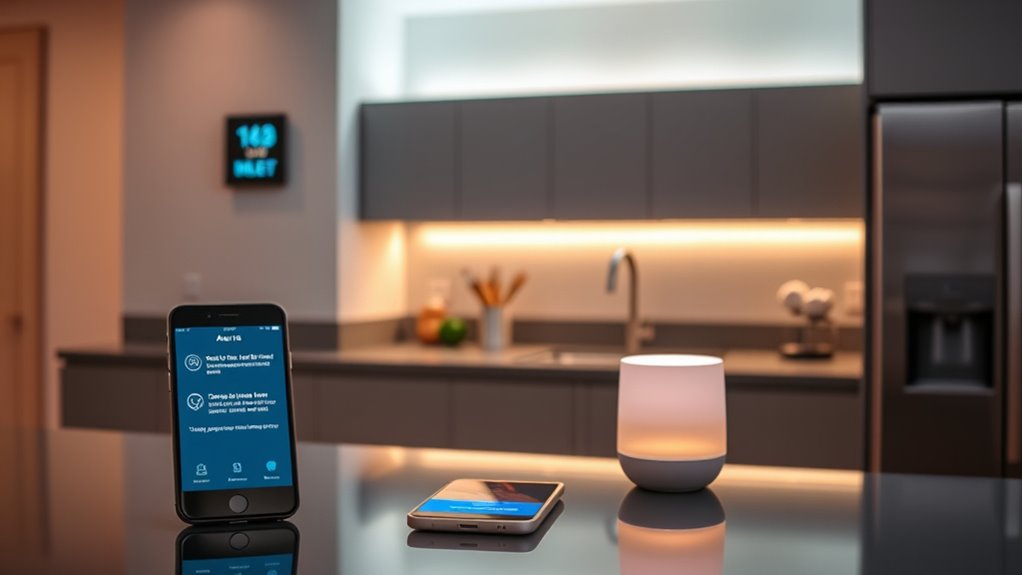
Since most modern appliances are connected to smart devices and home automation systems, you can receive real-time alerts directly on your mobile device or through smart assistants like Alexa or Google Assistant. When an appliance detects a problem—such as overheating, leaks, or electrical faults—it sends an instant notification so you can act quickly. This immediate communication helps you prevent bigger issues, like fires or water damage. You can also set up voice alerts, enabling you to hear alerts through your smart speaker without checking your phone. These alerts keep you informed no matter where you are, giving you peace of mind and control over your home’s safety. With real-time notifications, you’re always aware of your appliances’ status, allowing for prompt intervention when needed.
Customizing Safety Settings for Different Appliances
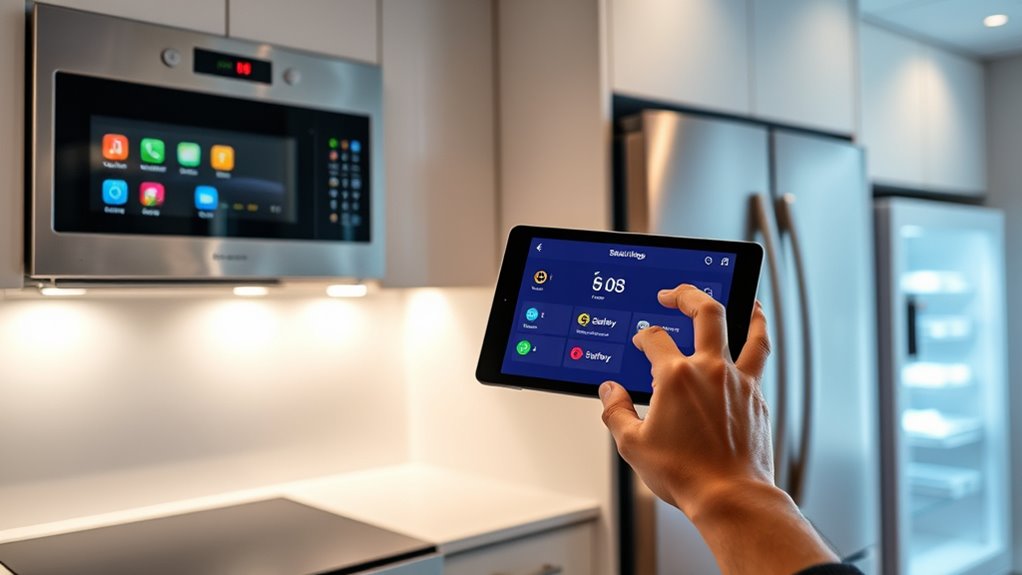
Customizing safety settings for different appliances allows you to tailor alerts and protections based on each device’s unique function and risk factors. By adjusting these settings, you guarantee that you receive relevant notifications without unnecessary interruptions. To optimize your safety system, consider these steps:
- Set specific temperature or power thresholds for high-risk appliances like ovens or heaters.
- Assign priority levels to critical devices, ensuring immediate alerts for safety concerns.
- Customize notification types, such as alarms or mobile alerts, depending on the appliance’s importance and usage patterns.
This targeted approach helps prevent accidents, reduces false alarms, and keeps you informed about potential issues specific to each appliance, making your home safer and more efficient.
The Role of AI and Machine Learning in Predictive Safety
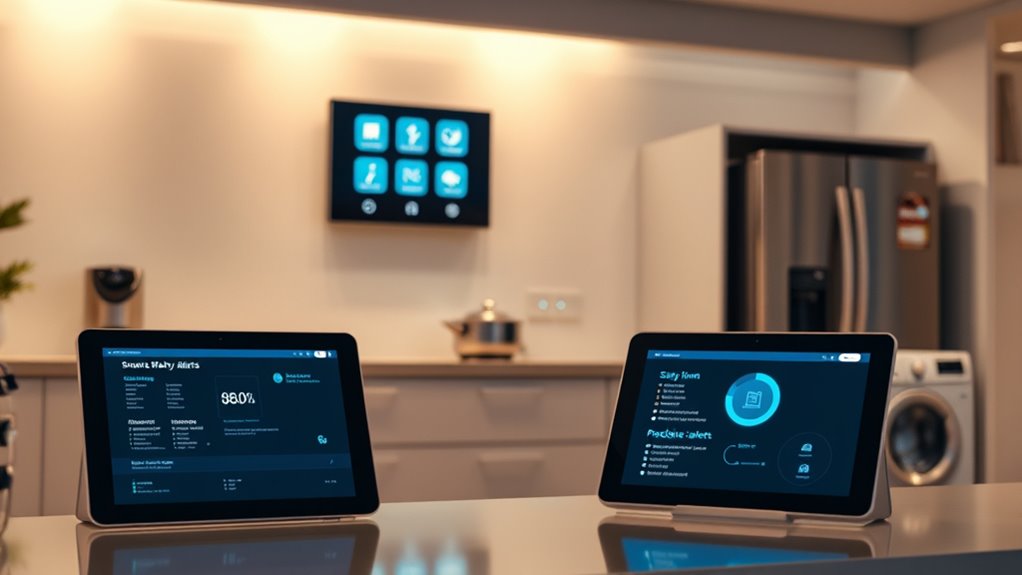
AI and machine learning are transforming predictive safety by analyzing vast amounts of data to identify potential hazards before they occur. These technologies monitor appliance performance, usage patterns, and environmental factors in real-time, enabling early detection of issues. For example, they can recognize subtle signs of malfunction, overheating, or wear that might lead to failures or fire risks. By continuously learning from new data, AI systems improve their accuracy over time, providing timely alerts that help you take preventative action. This proactive approach minimizes the chances of accidents, reduces damage, and enhances overall safety. With AI-driven insights, you gain a smarter, more responsive home automation system that keeps your appliances safe and your family protected.
Benefits of Automated Shut-Off Features
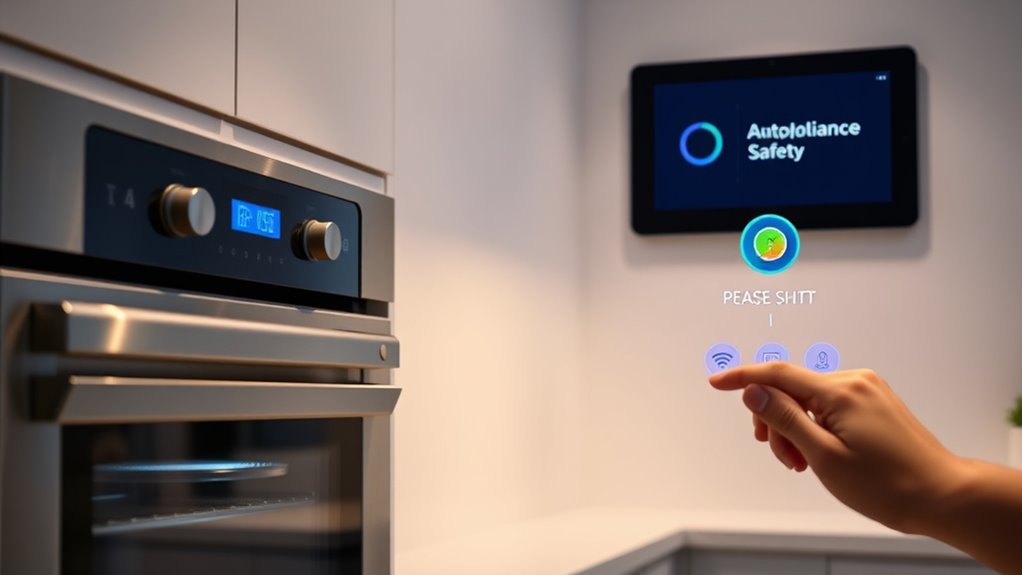
Automated shut-off features can prevent fire hazards by turning off appliances when they overheat or malfunction. They also help you save energy by stopping devices from running unnecessarily. With these safety measures, you gain peace of mind while protecting your home and reducing utility costs.
Prevents Fire Hazards
Automated shut-off features play a crucial role in preventing fire hazards by instantly cutting power when appliances malfunction or overheat. These systems detect abnormal conditions and act swiftly to minimize risks. Here’s how they protect you:
- Early Detection: Sensors monitor temperature and electrical flow, catching issues before flames ignite.
- Rapid Response: Automatic shut-offs activate immediately, reducing the chance of a fire spreading.
- Continuous Monitoring: Smart systems provide real-time alerts, so you’re always aware of potential dangers.
Saves Energy Consumption
By shutting off appliances when they overheat or malfunction, these systems not only prevent fires but also substantially reduce energy waste. Automated shut-off features ensure devices operate only when needed, preventing unnecessary power consumption. This efficiency benefits your utility bills and reduces your carbon footprint.
| Appliance | Energy Saving Benefit |
|---|---|
| Heaters | Stops energy drain during downtime |
| Ovens | Prevents idle energy use |
| Refrigerators | Avoids unnecessary compressor run |
| Dishwashers | Runs only when full |
| Laundry Machines | Limits energy when idle |
Implementing these features helps you conserve energy, lower costs, and promote eco-friendly habits effortlessly. Automation makes managing energy use seamless, giving you peace of mind and supporting sustainability.
Tips for Maintaining and Updating Safety Alert Systems

Keeping your safety alert systems up to date is essential for guaranteeing they function correctly when you need them most. Regular maintenance helps prevent malfunctions and keeps your home protected. Here are three key tips:
- Schedule regular software updates to ensure your system has the latest security patches and features.
- Test alarms monthly to confirm they activate properly and alert you promptly.
- Replace batteries annually or as needed to maintain reliable operation.
Frequently Asked Questions
Can Safety Alert Systems Differentiate Between False Alarms and Real Hazards?
You wonder if safety alert systems can tell false alarms from real dangers. Modern systems use smart sensors and AI to analyze data, reducing false alarms. They can differentiate between harmless triggers and actual hazards by recognizing patterns and verifying conditions. This technology helps you avoid unnecessary panic, ensuring you get alerts only when there’s a genuine threat, making your home safer and more reliable.
How Do Safety Alerts Integrate With Existing Home Security Systems?
Safety system syncs seamlessly with your security setup by sharing sensors and signals, simplifying security. When a sensor detects danger, alerts immediately activate, alerting you through your smartphone or home hub. You can customize alerts, ensuring you’re notified of potential problems without false alarms. This integration enhances your home’s safety, making monitoring more manageable and more meaningful—giving you peace of mind and prompt protection whenever you need it most.
Are There Privacy Concerns With Continuous Monitoring of Appliance Data?
You might worry about privacy when appliances constantly monitor data. While this helps prevent accidents, it can also mean your usage details are shared or stored online. To protect yourself, check if devices use secure encryption and limit data sharing. Stay informed about privacy policies, and opt for systems that give you control over what information is collected. Balancing safety with privacy guarantees you benefit without compromising your personal data.
What Is the Typical Maintenance Required for Safety Sensors?
Think of safety sensors as vigilant guardians watching over your appliances. You’ll need to regularly clean their surfaces to prevent dust buildup, which can block their view. Check for firmware updates to keep their alert systems sharp. Replace batteries when they run low, like fueling a trusted companion. Periodically test the sensors to verify they’re responsive, maintaining their watchful eye and protecting your home from potential hazards.
Can Safety Alerts Be Customized for Specific User Preferences or Schedules?
You can definitely customize safety alerts to match your preferences or schedule. Many home automation systems let you set specific alert types, times, or even mute alerts during certain periods. You just need to access your system’s app or control panel, choose your preferred settings, and save. This way, you’re always in control of how and when you get safety notifications, making your home both safer and more tailored to your lifestyle.
Conclusion
By embracing these smart safety alerts, you’re turning your home into a vigilant guardian, always watching over you. Think of your automation system as a trusted friend who detects trouble before it arrives, keeping hazards at bay like a lighthouse guiding ships safely to shore. With regular updates and thoughtful customization, you empower your appliances to protect you effortlessly. Ultimately, a well-tuned home safety system is your silent sentinel, making everyday living safer and more worry-free.
